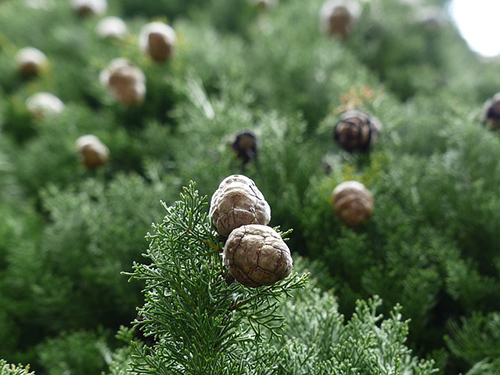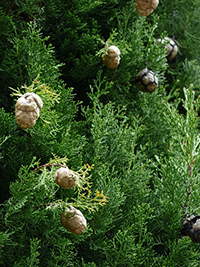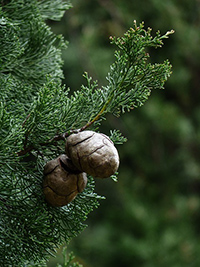Contents
The Italian cypress tree is almost sinister. It is firm and solemn next to the graveyard gates. With its crown, it points up towards the sky and the tombs with its elongated shadow, seemingly reminding humans of the fatal destiny awaiting us. It is the tree that best symbolizes death.
However, at the same time, the cypress is a sign of life and health for many people suffering from respiratory and circulatory diseases. In ancient Greece, sick individuals were sent to Cypress forests to regain health by inhaling their balsamic essences. Hippocrates and Galen recommended it as a medicinal plant. Since then, the cypress has been used successfully for over 2000 years as a healing tree.
In the Mexican state of Oaxaca, there is the famous Cypress of Moctezuma or Tule. It is 50 m high and 14 m in diameter and belongs to a very closely related species of the common cypress. It is supposed to be 4000 or 5000 years old. The Aztecs already employed cypress fruits (nuts) to avoid white hair and preserve their original color.

Italian Cypress Scientific Facts
- Other names: Cypress.
- French: Cypres.
- Spanish: Cipres.
- Environment: Native to the Middle East, it is now widespread throughout Europe and naturalized in America, where some varieties grow.
- Description: An evergreen tree of the Cupressaceae family, growing from 20 to 25 m high. Its fruit, called the cypress nut, is polyhedral and greyish-green colored.
- Parts of the tree used medicinally: Green fruits (nuts) and wood.
Healing Properties and Uses
The young branches and the fruit of the Italian cypress tree contain 0.2% to 1.2% of cypress essence, composed of several hydrocarbons, tannin, and aromatic substances. This tree has the following properties:

- Italian cypress tree benefits (1) Powerful venotonic: Its action is as intense as that of hazel, one of the most active plants known for blood circulation. Cypress is recommended to fight varicose veins, varicose ulceration, and hemorrhoids and may be taken internally and in external local applications.
- Italian cypress tree benefits (2) Vasoconstrictor: It contracts blood vessels. It is especially recommended during menopause to stop frequent metrorrhagia (uterine hemorrhages) caused by the congestion of the uterus (womb) and related to the hormonal imbalance typical at this stage of women’s lives.
- Italian cypress tree benefits (3) Urinary bladder strengthener: Increases the tone of the urinary bladder and allows better control of the autonomic nervous system on the muscles of this organ. In internal use or sitz baths, it is recommended for cases of daily or night urine incontinence and prostatic syndrome (difficulty in urinating due to an increase in the size of the prostate).
- Italian cypress tree benefits (4): Astringent: Due to the tannins it contains, it is used in cases of colitis or diarrhea.
- Italian cypress tree benefits (5): It is Sudorific, diuretic, and febrifuge. It treats bronchial catarrhs, bronchitis, colds, and influenza.
The essence of cypress also has balsamic, antitussive, and expectorant properties.

How to use Cypress
- Decoction with 20-30 g of groundnuts (fruits) or the same amount of wood per liter of water. Boil for 10 minutes and strain. Drink one cup before each meal (three or four cups daily).
- Essence. Take from 2 to 4 drops three times a day.
- Sitz bath. To treat hemorrhoids, use a decoction similar to that employed in internal use but with a higher concentration of nuts (some 50 g per liter). Take three baths a day with cold water. This reduces the size of hemorrhoids and eases their pain.
- Inhalations. Those suffering from bronchial catarrh will benefit from inhalations by adding cypress nuts or drops of cypress essence to the water.
- Compresses on the legs, with the same decoction, are employed for internal use.
DISCLAIMER: All content on this website is presented solely for educational and informational objectives. Do not rely on the information provided as a replacement for advice, diagnosis, or treatment from a qualified medical expert. If you are pregnant, nursing, or have any preexisting medical concerns, talk to your doctor before using any herbal or natural medicines.
REFERENCES
- George D. Pamplona-Roger, M.D. “Encyclopedia of Medicinal Plants.” George D. Pamplona-Roger, M.D. Encyclopedia of Medicinal Plants. Ed. Francesc X. Gelabert. Vols. 1 San Fernando de Henares: Editorial Safeliz, 2000. 255, 256. Print.
- https://pubmed.ncbi.nlm.nih.gov/22728002/
- https://pubmed.ncbi.nlm.nih.gov/21717321/
- https://www.ncbi.nlm.nih.gov/pmc/articles/PMC7929343/
